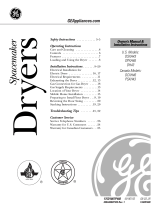
If exhaust ductwork must run through an unheated area, the duct should be insulated and slope slightly down
towards the exhaust hood to reduce condensation and lint build-up.
If an existing exhaust system is to be used with your new dryer, you must be sure:
• The exhaust system meets all local, state and national codes.
• That plastic flexible duct is not used.
• To completely inspect and clean all lint accumulation from the interior of the duct.
• The duct is not kinked or crushed.
• The exhaust hood damper opens and closes freely.
The static pressure in any exhaust system must not exceed 0.92 inches of water column, or be less than 0.
This can be measured with the dryer running with a manometer at the point where the exhaust duct connects
to the dryer. A no heat setting should be used. The dryer tumbler should be empty and the lint filter clean.
Inspect and clean the interior or the exhaust system at least once a year. Disconnect electrical service prior
to cleaning. Check the gas line on gas dryers anytime the dryer is moved.
Frequently check to be sure the exhaust hood damper opens and closes freely.
NONEXHAUSTED INSTALLATIONS
If the electric dryer is not exhausted to the outside, the exhaust must not terminate directly behind the dryer.
Use a rectangular vent kit along with a dacron mesh lint bag (see Accessories). Maintain a 6” (15.2 cm)
clearance between the back of the control panel and the wall. Although the lint screen and lint bag will retain
most of the lint, a certain amount will be expelled into the laundry area.
WARNING: IF THE DRYER IS NOT EXHAUSTED TOTHE OUTSIDE, SOME FINE LINT WILL BE
EXPELLED INTO THE LAUNDRY AREA. AN ACCUMULATION OF DUST OR LINT IN ANY AREA OF THE
HOME CREATES A FIRE HAZARD. ANY LINT ACCUMULATIONS MUST BE CLEANED FREQUENTLY.
GAS REQUIREMENTS
Use only Natural or LP (liquid propane) gases.
THE INSTALLATION MUST CONFORM WITH LOCAL CODES,OR IN THE ABSENCE OF LOCAL CODES,
WITH THE NATIONAL FUEL GAS CODE ANSI/Z223.1, LATEST REVISION (FOR THE UNITED STATES),
OR WITH THE CAN/CGA-B149 INSTALLATION CODES (FOR CANADA).
Gas dryers are equipped with a burner orifice for operation on NATURAL gas. If the dryer is to be operated
on LP (liquid propane) gas, it must be converted for safe and proper performance and must be
converted by a qualified service technician. Conversion kits from NATURAL to LP, or LP to NATURAL are
available through your local Maytag dealer (see Accessories). If other conversions are required, check with
the local gas utility for specific information concerning conversion requirements.
A 1/2” (1.27 cm) gas supply line is recommended and must be reduced to connect to the 3/8” (1.0 cm) gas line
on the drye r.
The National Fuel Gas Code requires that an accessible, approved manual gas shut off valve be installed
within 6 feet of the dryer.
Additionally, a 1/8” (.3 cm) N.P.T. (National Pipe Thread) plugged tapping, accessible for test gauge
connection, must be installed immediately upstream of the gas supply connection to the dryer.
The dryer must be disconnected from the gas supply piping system during any pressure testing of the system.
DO NOT re-use old flexible metal gas line. Flexible gas line must be design certified by American Gas
Association (CGA in Canada). NOTE: Any pipe joint compound used must be resistant to the action of any
liquefied petroleum gas.
NOTE: As a courtesy, most local gas utilities will inspect a gas appliance installation.
GAS IGNITION –
This dryer uses an automatic ignition system to ignite the bu rn e r. There is no constant burning pilot.












